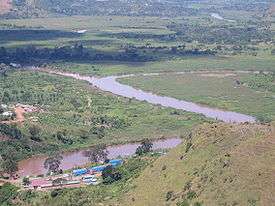Kagera River
| Kagera | |
| Akagera | |
| River | |
 The confluence of the Kagera and Ruvubu rivers near Rusumo Falls, Rwanda/Tanzania | |
| Countries | Burundi, Rwanda, Tanzania, Uganda |
|---|---|
| Source confluence | near Lake Tanganyika |
| Mouth | |
| - location | Lake Victoria |
The Kagera River, also Akagera River, or Alexandra Nile, is an East African river, forming part of the upper headwaters of the Nile and carrying water from its most distant source.[1]:167
The section of river named Kagera begins in Burundi, flowing out from Lake Rweru. From the lake, it flows east along the Rwanda-Burundi and Rwanda-Tanzania borders to a confluence with the Ruvubu River. The waters of the Kagera are thus provided by two major tributaries, the Nyabarongo of Rwanda, which feeds Lake Rweru, and the Ruvubu of Burundi. It is unknown which of these two feeder rivers is the longer and hence the ultimate source of the Nile. From the confluence, the Kagera flows north along the Rwanda-Tanzania border, over Rusumo Falls and through Akagera National Park. It then takes a turn to the east, following the Tanzania-Uganda border and emptying into Lake Victoria in Uganda.
The river has featured prominently in the histories of the countries it runs through, particularly Rwanda. In 1894, German Gustav Adolf von Götzen crossed the Kagera at Rusumo Falls, beginning the Rwandan colonial era; and in 1916, during World War I, the Belgians defeated the Germans, entering Rwanda by the same route. The river gained international notoriety in 1994 for carrying bodies from the Rwandan Genocide into Lake Victoria, causing a state of emergency to be declared in areas of Uganda, where these bodies eventually washed up.
Geography
The Kagera rises in Burundi and flows into Lake Victoria. It is the largest single inflow into the lake, contributing approximately 6.4 billion cubic metres of water a year (about 28 per cent of the lake's outflow).[2] The Kagera is formed by the confluence of the Ruvuvu and the Nyabarongo, close to the northernmost point of Lake Tanganyika.[3] It forms parts of the Burundi–Tanzania, Rwanda–Tanzania, Burundi–Rwanda, and Tanzania–Uganda borders. It lends its name to Akagera National Park in northern Rwanda, as well as to the Kagera Region of Tanzania. On the river are the Rusumo Falls, an important crossing point between Rwanda and Tanzania. It is near the town of Rusumo.
Genocide
During the Rwandan Genocide of 1994, the Kagera was used to dispose of corpses as thousands of Tutsis and Hutu political moderates were murdered on the river banks.[4] The river brought the massacred bodies into Lake Victoria, creating a serious health hazard in Uganda.[5]
References
Notes
- ↑ Stanley, H.M., 1899, Through the Dark Continent, London: G. Newnes, ISBN 0486256677
- ↑ Rangeley, p. 54
- ↑ Dumont, p. 341
- ↑ January, p. 83
- ↑ Lorch, Donatella (21 May 1994), "Thousands of Rwanda Dead Wash Down to Lake Victoria", The New York Times, retrieved 26 February 2010
Sources
- Dumont, Henri J. (2009). The Nile: Origin, Environments, Limnology and Human Use. Springer. ISBN 1-4020-9725-5.
- January, Brendan (2007). Genocide: modern crimes against humanity. Twenty-First Century Books. ISBN 0-7613-3421-1.
- Rangeley, Robert (1994). International river basin organizations in sub-Saharan Africa. World Bank Publications. ISBN 0-8213-2871-9.,
External links
| Wikimedia Commons has media related to Kagera River. |
 "Kagera". Encyclopædia Britannica (11th ed.). 1911.
"Kagera". Encyclopædia Britannica (11th ed.). 1911.
Coordinates: 0°56′41″S 31°46′36″E / 0.944722°S 31.7767°E